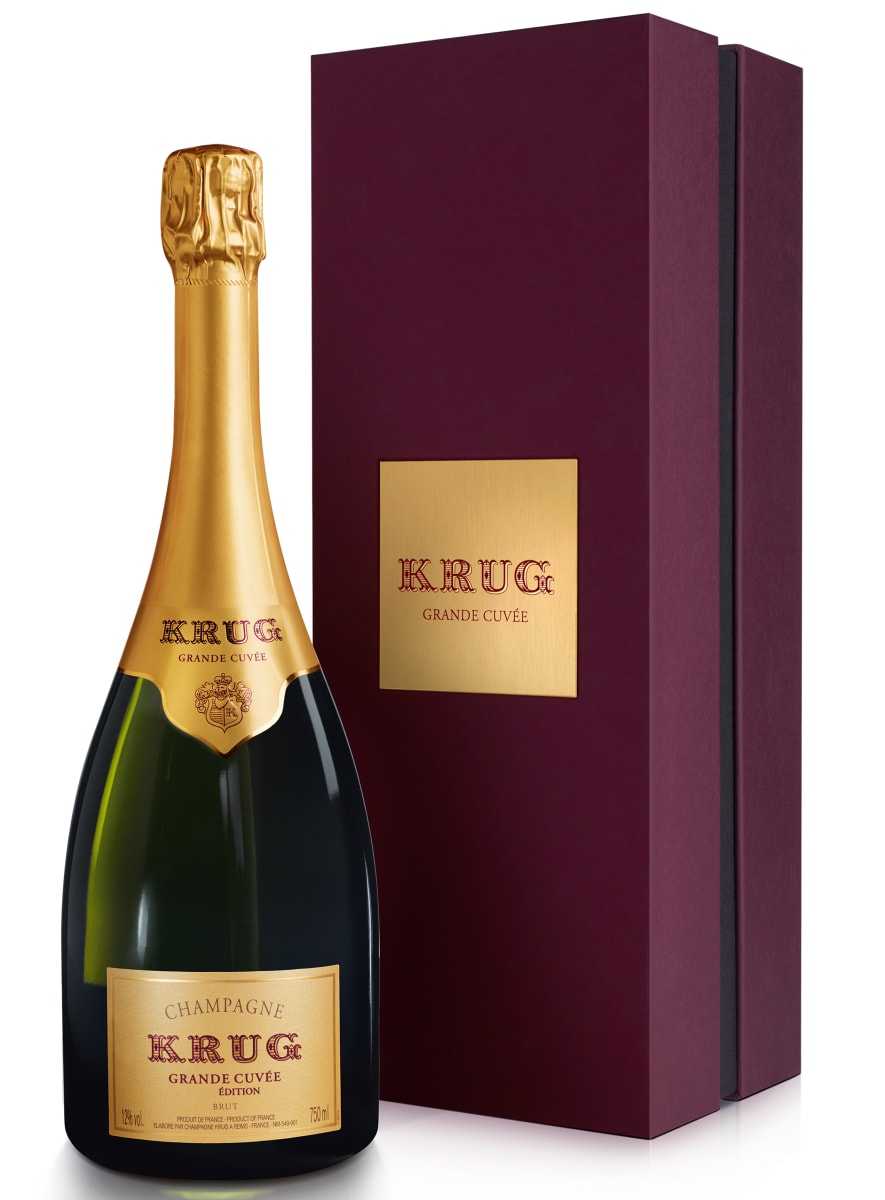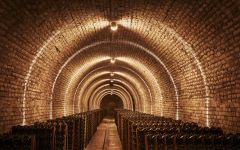Krug Grande Cuvee Brut (168th Edition) with Gift Box
-
Jeb
Dunnuck - Decanter
-
Wine
Enthusiast -
Robert
Parker -
Wine
Spectator




Product Details
Your Rating
Somm Note
Winemaker Notes
Deep golden colour and fine, vivacious bubbles, predictingfullness and elegance. Aromas of flowers in bloom, ripe & dried fruit, marzipan, gingerbread and citrus fruits. Flavors of hazelnut, nougat, barley sugar, jellied and citrus fruits, almonds, brioche and honey.
Krug Grande Cuvée lends itself to a plethora of culinary combinations, from the simplest to the most sophisticated, from an extra mature parmesan to a dish of turbot à la truffe.
Professional Ratings
-
Jeb Dunnuck
A beautiful Champagne, yet one that needs bottle age, the NV Grand Cuvee 168ème Edition comes mostly from the 2012 vintage (a good vintage) and has gorgeous apple blossom and stone fruits intermixed with classic Krug toasted brioche, toasted almond, white flowers, and honeysuckle aromatics. Just gorgeous on the palate as well, it's concentrated and has a rich, backward texture, bright acidity, and great finish. It takes lots of air to show at its best today, but do your best to hide bottles for 3-4 years. You'll be rewarded and it will evolve gracefully for another two decades or more.
-
Decanter
52% Pinot Noir, 35% Chardonnay, 13% Pinot Meunier. A gentle gold with discreet yet persistent mousse and aromatics of spring meadows, lemon sherbet and barley sugar; the wine is pure and softly powerful, youthful energy finely poised, somewhat cautious after so many years in the chalky cellars. The reserve wines, Pinot Noir from Verzenay and Chardonnay from Avize especially, are subtle in support, vivacious despite their relative maturity, contributing to an ensemble which is hitherto dominated by red fruit, courtesy of the superb Pinot Noir, and a colourful tension. Behind that there are whispers of honey, quince and posset… and with so much more to come; but the finish, happily in these days of privation, takes one to wherever one may wish to go.
Drinking Window 2020 - 2037
-
Wine Enthusiast
In line with the producer's practice of numbering each bottling of its flagship Grande Cuvée, this is the latest release. Following the house style, there is some marvelously impressive Pinot Noir in this rich, full blend. That gives the Champagne its luxurious feel, contrasting with the tension from the dryness and minerality. This bottling, which shows maturity, is ready to drink.
-
Robert Parker's Wine Advocate
Krug's NV Grande Cuvée 168ème Édition is a classic in the making, wafting from the glass with aromas of dried fruits, pear, toasted nuts, orange zest, honeycomb and freshly baked bread. Medium to full-bodied, generous but incisive, it's deep and elegantly fleshy, with a beautifully refined mousse and an enveloping core of fruit that's complemented by the characteristic Krug patina of nutty complexity imparted by barrel fermentation. Even if this is more open out of the gates than the 2011-based 167ème edition, the 168ème edition is also the more concentrated and intense of the two. It's based on the 2012 harvest, complemented by fully 42% reserve wines—a blend of 198 wines from 11 different vintages dating back to 1996.
-
Wine Spectator
A seamless Champagne, effortlessly integrating a powerful spine of racy acidity with the detailed range of crème de cassis, raw almond, toasted saffron and candied ginger flavors. This is fine and silky in texture, with a tang of salty mineral and rich hints of coffee, toasted brioche and mandarin orange peel expanding on the finish. Disgorged winter 2018. Drink now through 2030.









Krug has always lived up to its reputation as the first and only Champagne House to create exclusively prestige Champagnes every year since its foundation.
The House was established in Reims in 1843, by Joseph Krug, a visionary non-conformist with an uncompromising philosophy. Having understood that the true essence of Champagne is pleasure itself, his dream was to craft the very best Champagne he could offer, every single year, regardless of annual variations in climate. Paying close attention to the vineyard’s character, respecting the individuality of each plot and its wine, as well as building an extensive library of reserve wines from many different years allowed Joseph Krug to fulfil his dream.
With a very original approach to Champagne making, he decided to go beyond the notion of vintage to create the most generous expression of Champagne, every year. Thus, he founded a House in which all Champagnes are of the same level of distinction.
Six generations of the Krug family have perpetuated this dream, enriching the founder’s vision and savoir faire.
Further elaborating on the notion of individuality, for Krug’s Cellar Master Julie Cavil, each plot of grapes, through its wine, is like a single ingredient to a chef: carefully selected, and critical to the final composition. Each year, Krug honors this philosophy by inviting chefs from around the world to interpret a single ingredient, crafting unexpected recipes to pair with a glass of Krug Grande Cuvée or Krug Rosé. This year’s ingredient is the Onion.
The unspoken onion is a key component of almost every fundamental recipe from stocks, sauces and stews to baked goods and roasts. Its multifaceted expressions beautifully marry both the fullness of flavors and aromas of Krug Grande Cuvée the elegance and boldness of Krug Rose.

A term typically reserved for Champagne and Sparkling Wines, non-vintage or simply “NV” on a label indicates a blend of finished wines from different vintages (years of harvest). To make non-vintage Champagne, typically the current year’s harvest (in other words, the current vintage) forms the base of the blend. Finished wines from previous years, called “vins de reserve” are blended in at approximately 10-50% of the total volume in order to achieve the flavor, complexity, body and acidity for the desired house style. A tiny proportion of Champagnes are made from a single vintage.
There are also some very large production still wines that may not claim one particular vintage. This would be at the discretion of the winemaker’s goals for character of the final wine.

Associated with luxury, celebration, and romance, the region, Champagne, is home to the world’s most prized sparkling wine. In order to bear the label, ‘Champagne’, a sparkling wine must originate from this northeastern region of France—called Champagne—and adhere to strict quality standards. Made up of the three towns Reims, Épernay, and Aÿ, it was here that the traditional method of sparkling wine production was both invented and perfected, birthing a winemaking technique as well as a flavor profile that is now emulated worldwide.
Well-drained, limestone and chalky soil defines much of the region, which lend a mineral component to its wines. Champagne’s cold, continental climate promotes ample acidity in its grapes but weather differences from year to year can create significant variation between vintages. While vintage Champagnes are produced in exceptional years, non-vintage cuvées are produced annually from a blend of several years in order to produce Champagnes that maintain a consistent house style.
With nearly negligible exceptions, . These can be blended together or bottled as individual varietal Champagnes, depending on the final style of wine desired. Chardonnay, the only white variety, contributes freshness, elegance, lively acidity and notes of citrus, orchard fruit and white flowers. Pinot Noir and its relative Pinot Meunier, provide the backbone to many blends, adding structure, body and supple red fruit flavors. Wines with a large proportion of Pinot Meunier will be ready to drink earlier, while Pinot Noir contributes to longevity. Whether it is white or rosé, most Champagne is made from a blend of red and white grapes—and uniquely, rosé is often produce by blending together red and white wine. A Champagne made exclusively from Chardonnay will be labeled as ‘blanc de blancs,’ while ones comprised of only red grapes are called ‘blanc de noirs.’
